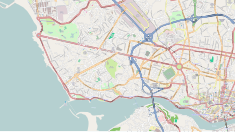Dom Luís Bridge, Porto
|
Dom Luís I Bridge Ponte de D. Luís |
|
|---|---|

A view of the bridge as seen of the southern margin of Vila Nova de Gaia, in the parish of Santa Marinha e São Pedro da Afurada
|
|
| Coordinates | 41°08′24″N 8°36′34″W / 41.139863°N 8.609336°WCoordinates: 41°08′24″N 8°36′34″W / 41.139863°N 8.609336°W |
| Carries |
Light rail line and pedestrians (upper deck) General traffic and pedestrians (lower deck) |
| Crosses | Rio Douro |
| Locale | Porto, between the City of Porto proper and Vila Nova de Gaia |
| Official name | Ponte de D. Luís |
| Heritage status |
Property of Public Interest Imóvel de Interesse Público; Decree 28/82, Diário da República, Série 1, 47 (26 February 1982); Included in the Historic Centre of the City of Porto (PT011312140163) and partially included in the Historic Zone of the City of Porto (PT011312070086) |
| SIPA Identification | IPA.0000554/PT011312140057 |
| Preceded by | Ponte Pênsil |
| Characteristics | |
| Design | Two-hinged double-deck arch bridge |
| Material | Iron |
| Trough construction | Granite |
| Pier construction | Asphalt |
| Total length | Two decks of varying lengths: 172 metres (564 ft) (lower deck) and 395.25 metres (1,296.8 ft) |
| Width | 8 metres (26 ft) vehicular width (between pedestrian walkways) |
| Height | 85 metres (279 ft) |
| Longest span | 395.25 metres (1,296.8 ft) |
| History | |
| Architect | Théophile Seyrig |
| Constructed by | Société Willebreck |
| Construction start | 21 November 1881 |
| Construction end | 30 October 1886 |
| Construction cost | 369,000$00 réis |
| Inaugurated | 31 October 1886 |
| Statistics | |
| Toll | 1 November 1886-1 January 1944 |
The Dom Luís I Bridge (Portuguese: Ponte D. Luís I) is a double-deck metal arch bridge that spans the River Douro between the cities of Porto and Vila Nova de Gaia in Portugal. At its construction, its 172 metres (564 ft) span was the longest of its type in the world. It has been confused with the nearby Maria Pia Bridge, a railway bridge that was built 9 years earlier (and located 1 kilometre (0.62 mi) to the east), that is similar in aspect to the Dom Luís bridge.
In 1879, Gustave Eiffel presented a project to construct a new bridge over the Douro, with a single deck in order to facilitate navigation. This project was rejected due to dramatic growth of the urban population, which required a re-thinking of the limits of a single-deck platform.
A competition was initiated in November 1880, in order to construct a double-deck metal bridge, which included projects by Compagnie de Fives-Lille, Cail & C., Schneider & Co., Gustave Eiffel, Lecoq & Co., Société de Braine-le-Comte, Société dês Batognolles (which submitted two ideas), Andrew Handyside & Co., Société de Construction de Willebroek (also two projects) and John Dixon. It was in January of the following year that deliberations by the committee supported the project of Société de Willebroek, a design that cost 369 000$000 réis, and provided better conditions. On 21 November 1881, the public work was adjudicated to the Belgian society Société Willebreck, from Brussels, for 402 contos, and administrated by Théophile Seyrig, a disciple of Gustave Eiffel, and author of the project. Consequently, the design resembled that of the D. Maria bridge. Construction began on the Ponte D. Luís I, along the flanks of the towers of Ponte Pênsil, but were disassembled.
By 26 May 1886, the first weight experiments began, with the transport of a 2,000 kilograms (4,400 lb) per metre. On 30 October construction of the main arch and upper deck were concluded, resulting in its inauguration the very next day. On 1 November, a toll system began to operate under the administration of the winning company, that was equal to 4 reís per person. The following year the lower deck was inaugurated, completing the project. During its ceremonies, the bridge was blessed by Bishop D. Américo.
...
Wikipedia

